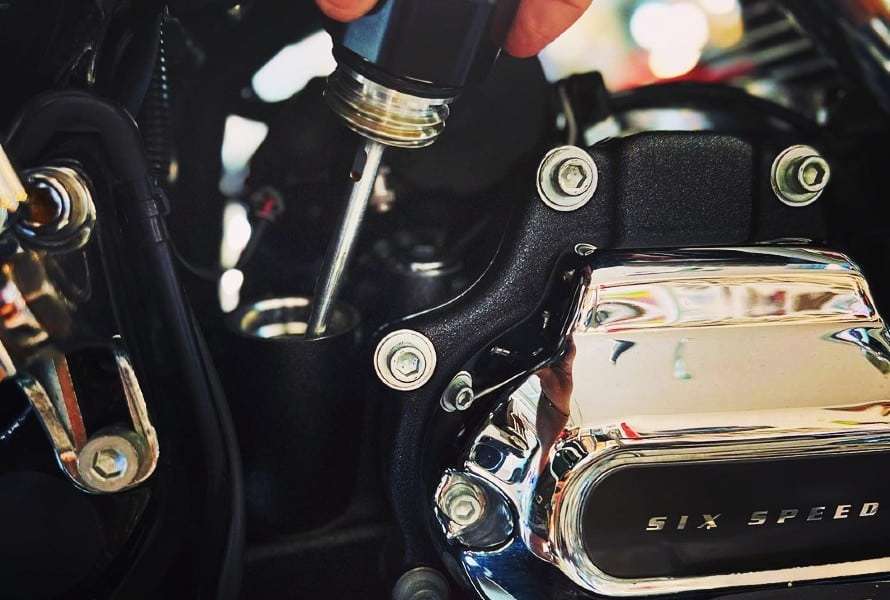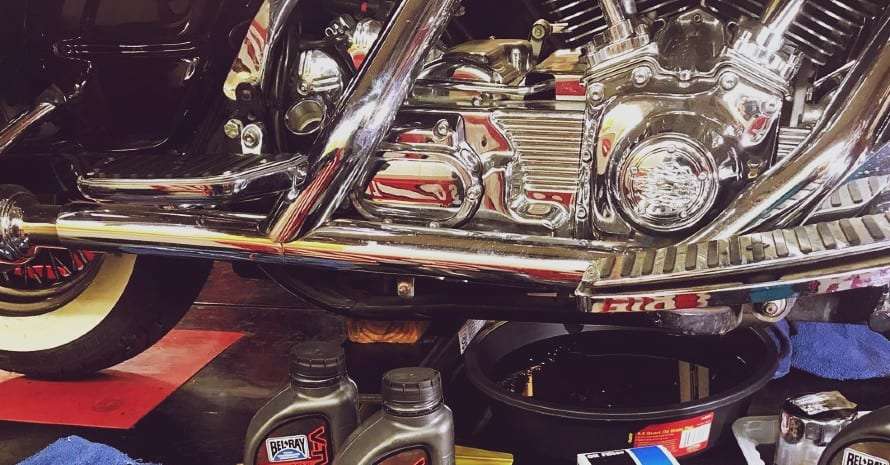Regular oil changes are important for several reasons. First, it is to prevent engine damage. Oil protects the engine by lubricating moving parts and keeping them cool.
Another reason is to improve performance. Over time, oil degrades and becomes less effective at lubricating the engine and keeping it cool. This can lead to a loss of power and efficiency. Regular changes can help keep your bike running optimally.
Finally, changing the oil can extend the life of the engine. By keeping it well-lubricated and cool, you can prevent it from wearing out prematurely. This will help keep your iron horse running for years to come.
In this article, you’ll learn all about oil changes for motorcycles, and we’ll teach you how to tell if it’s time for a new lubricant.
How Often Should You Change Your Motorcycle Oil?
It is generally accepted that the oil should be changed every 2,000 to 3,000 miles and at least once a year. However, factors such as the type of oil you use, how often you ride, and the conditions in which you ride should also be considered. For example, synthetic can be changed less frequently every 7,000 to 10,000 miles.
If you use mineral-based oil, you should change it at least every 2,000 miles. If it’s semi-synthetic, you can wait a little longer between changes, about 5,000-6,000 miles. And if you’re using fully synthetic, you can wait even longer – about 7,000 to 10,000 miles. However, these are just general recommendations. If you feel your oil is dirty or your engine is not running well, you should change it, regardless of the number of miles you’ve logged.
The type of lubricant you use is not the only factor that determines how often you should change it. The conditions in which you drive can also affect the condition of your engine oil. If you drive in harsh conditions, such as extreme temperatures, dusty environments, or heavy loads, you should change your lube more often.
In general, you should change it once a year or after 3,000 to 5,000 miles. But if you use your bike more regularly or ride in harsher conditions, you may need more frequent changes.
What Does Motorcycle Engine Oil Do?
Motorcycle engine oil serves several purposes. It lubricates the engine, cleans it, and protects it.
Lubrication
The main purpose of motorcycle motor oil is to lubricate the engine. To do this, a thin layer of lubricant forms between the moving parts. It reduces friction and wear on engine parts and helps keep the engine cool by dissipating heat.
Cleaning
It also contains additives that help clean the engine. These additives break down and remove deposits and fouling on its parts. This helps to keep the engine clean and keep it running smoothly.
Protection
The additives found in the lubricant also protect the engine from rust, corrosion, and wear. They form a protective barrier on its parts and help extend its service life.
How To Check Your Oil Level and Condition?
There are different ways depending on the model of your motorcycle. They are all described below.

Using a Dip Stick
The best way to check the oil level is to use a dipstick. Most vehicles have it at the front of the engine, at the bottom. To check the oil level, remove the dipstick and wipe it with a rag. Then put it back in and pull it out again. The oil level should be somewhere between the “low” and “high” marks on the dipstick.
If the oil level is below the “low” mark, top up the oil. If the level is above the “high” mark, there is too much grease, and it must be removed.
Remove the Oil Level Plug
Another way to check the oil level is to remove the oil level plug. This is a small plug located next to the dipstick (on some bikes, the dipstick and oil level plug are the same things).
To remove the oil level plug, use a wrench to loosen it and then pull it out. Oil should begin to flow out. When it stops, the oil level should be somewhere between the “low” and “high” marks on the plug. If not, add or remove oil as needed.
Using A Sight Glass
Some bikes have a sight glass instead of a dipstick. This is a small glass window located at the front of the engine. To check the motorcycle’s oil level, just look through it and see where the oil level is. It should be between the “low” and “high” marks.
If your motorbike doesn’t have a dipstick or sight glass, you’ll need to refer to your owner’s manual to find out where to check the oil level.
Don’t Forget to Keep the Oil Clean
After you’ve checked the level, look at the oil itself. It should be an amber color. If it’s black or dark brown, it’s time to change it.
If you’re unsure of the oil level or condition, it’s best to take your two-wheeler to a mechanic to have it checked.
How to Change Motorcycle Oil

It’s a fairly simple process, but it’s always a good idea to consult your owner’s manual before you get started.
To change your motorcycle lubricant, you’ll need:
- motorbike oil;
- oil filter;
- oil filter wrench;
- funnel;
- clean and dry rags;
- container for old oil.
To change the grease, follow these steps:
- Warm up the engine. This will help loosen the oil and make it easier to drain.
- Place a pan under the engine to collect the old oil.
- Remove the drain plug and drain the oil.
- Replace the oil filter.
- Pour fresh lubricant into the engine.
- Replace the oil filler cap and start the engine.
- Check the lubricant level and add oil if necessary.
- Ride your motorcycle for a test ride.
After replacing the lubricant in your motorcycle, remember to dispose of the old one properly. You can usually take it to your local garage or service station and recycle it.
When to Change Your Motorcycle Oil
As we said, the frequency depends on several factors, including:
- the type of lubricant you use;
- how often do you ride your motorcycle;
- what conditions you ride in (such as city traffic with stops and crossings or long stretches of highway).
Generally, most motorcyclists change their oil every 3,000 miles or every 6 months, but at least once a year, whichever comes first. However, it’s always a good idea to check your owner’s manual to see what the manufacturer recommends.
What Engine Oil Should I Use on My Motorcycle?
As the owner of an iron horse, it is very important for you to understand what oil is best for it.
In general, there are three types of motorcycle oil:
- Mineral-based is the most common type of lubricant. It’s great for old two-wheeled friends who often have leaks due to modern synthetic. This is because mineral-based is thicker than synthetic;
- Synthetic is a man-made grease designed for longer use and withstands higher temperatures. This is a good choice for sports bikes or for bikes that are ridden in hot weather;
- Semi-synthetic oil is a blend of synthetic and mineral-based oils. It’s a good choice for motorcycles operated in mild conditions.
What Engine Oil Should You Use on Two-Stroke Motorcycles?
Oil and fuel burn together in the combustion chamber in two-stroke engines, so it is important to use a lubricant designed for that purpose. Lubricant for four-stroke engines is not designed to burn in the combustion chamber, and it can lead to engine failure if you use it instead of the right oil for your bike. So for high-performance two-stroke engines, buy a synthetic engine oil that provides the best engine protection and cooling.
Most importantly, always read the label before you buy oil, so you know you’ve found the right product for your engine. Otherwise, you might end up with a breakdown and overhaul.
Should I Change the Oil Filter Every Time I Change the Oil?
Most motorcycle experts agree that changing the oil filter at every oil change is the best way to keep your motorcycle running smoothly and extend its life. Here are a few reasons why this is the case:
It’s the Best Way to Remove Contaminants
Over time, your motorcycle oil inevitably gets contaminated with dirt, debris, and other particles. These contaminants can clog the oil filter, reducing its efficiency. Therefore, it is important to change it regularly so that it can do its job properly.
Prevents Oil Starvation
If the oil filter gets clogged, it can restrict the flow of oil to the engine, leading to oil starvation. This can cause serious engine damage and, in some cases, even damage to your motorcycle. By changing the filter regularly, you can prevent this from happening.
It’s Cheap and Easy
Changing your motorcycle oil filter is a relatively simple and inexpensive task. It’s worth doing to keep your motorcycle running smoothly and extend its life.
When Should a Motorcycle Filter Be Changed?
As a general rule of thumb, it should be changed at every oil change. However, if you’re using non-synthetic oil, you can extend the interval between filter changes. Ultimately, it is best to consult a qualified motorcycle mechanic or consult your bike’s manual to determine the optimal interval for your particular motorcycle.
FAQ
How will I know if motorcycle oil is dirty?
There are several ways to tell if your motorcycle oil is contaminated and needs to be changed, as follows:
- check the level on the dipstick. If it is low, it could be a sign that the lubricant is burning due to contamination;
- check the color. If it’s dark and cloudy, that’s another sign that it should be replaced;
- if your bike is running poorly or has lost power, this could also be a symptom of contamination;
- if you notice an increase in engine noise, it could be a sign that the grease is no longer doing its purpose properly and needs to be replaced.
Should you change your motorcycle oil every year?
It is generally accepted that you should change your motorcycle oil every year, no matter how many miles you have driven. There are several reasons for this. First, it degrades over time, even if it is not used. This happens through a number of factors, including exposure to air and heat. Second, it gets dirty over time due to the accumulation of dirt, debris, and metal chips. These contaminants can cause a number of problems, including reduced performance, increased wear, and engine damage. Finally, an annual motorcycle oil change ensures that you’re using the most up-to-date lubricant with improved qualities.
How long can a motorcycle go without an oil change?
It’s generally accepted that you should change your motorcycle oil every 3,000 miles, but some riders have no problem bringing it up to 7,000 or even 10,000 miles. However, if you ride in particularly dusty or dirty conditions, it is recommended that you change your lubricant more frequently.
Conclusion
If you’ve read this article in its entirety, you now know why it’s important to change your engine oil on time and what a lack of basic maintenance on your iron horse can lead to. It’s just as important to choose the right product for your bike.
If you still have questions or are afraid to change the lubricant, contact an auto mechanic.
Bruce was born in Atlanta. He started riding motorcycles when he was 10 and has been passionate about them since. Bruce says he feels absolute freedom when he’s on two wheels. He prefers riding his bike slowly and smoothly along a country road and hardly ever enjoys wildly speedy rides. With a strong Ducati Multistrada 1200 in the current stable, Bruce enjoys his super powerful, comfortable and easy rides. Ducati Diavel is the beast he’s currently dreaming about…
